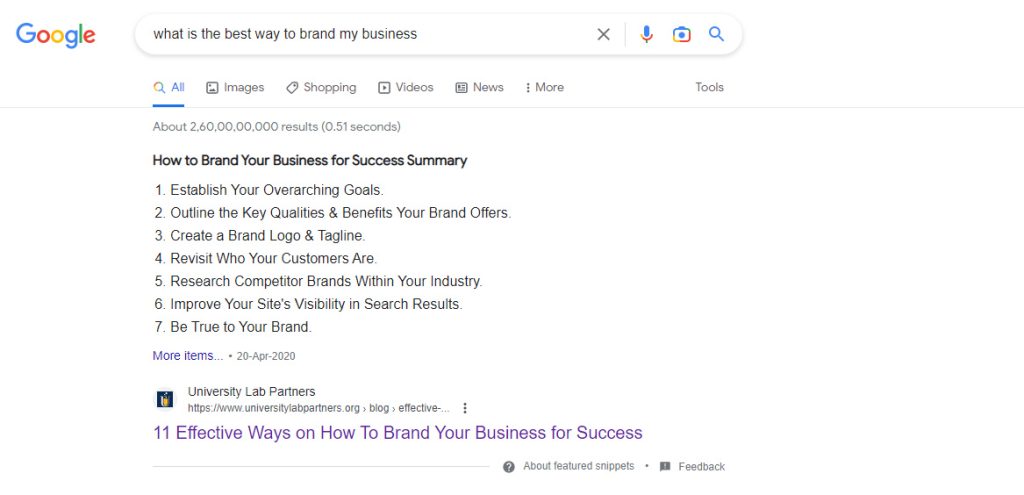Over the past few years, Google has been taking steps to improve the way it shows people results. Google has been displaying more featured snippets in response to user queries. As a result, organic results are actually pushed farther down the screen. Using organic SEO services can help businesses appear as featured snippets on Google and get more clicks from theorganicsearch results.
Featured Snippets and Its Significance
Featured snippets or answer boxesare types of content that are presented on the search engine results page (SERP) without requiring the user to go to the page where it is located. In an effort to better serve the user, Google places these snippets above standard SERP results but below the advertisements. There are different types of featured snippets, such as list, paragraph, table, accordion, rich answer, and tool or calculator.

Many SEO experts believedthat featured snippets would drastically reduce the number of users who actually click through to the pages within the results. But in reality, this hasn’t been the case – it has significantlyimproved the clickthrough rate (CTR) of results that are ranked within it. Since the answer boxes always show up at the top of the organic results in what is known as the “0th position,” snippets are highly visible to users. This can increase the likelihood that users will click through to your website and engage with your content
The key benefits of featured snippets are:
- increased visibility – featured snippets appear at the top of Google’s search results
- enhanced authority – being featured in a Google snippet can enhance your authority and credibility on a particular topic
- improved user experience – snippets make it easy for users to find the information they are looking for without having to click through to a website
- competitive advantage – by providing a concise and informative summary of your content, you can differentiate your website and attract more traffic
How to Optimize Your Content for Google’s Featured Snippets
- Use a ‘What is’ heading: You should start by looking for a spot in your content where you can insert a “What is [keyword]” heading tag. This will tell Google that the text you’ll write next might be valuable as a featured snippet. This heading should ideally be placed as high up in your material as possible. Make sure it fits in well with the content. Including this element makes it obvious to Google what content it may use for the featured snippet.
- Add “is” in sentence structure: An “is” statement must be used when optimizing for the featured snippet. The opening phrase should begin with the phrase “[Keyword] is…” For example, consider the sentence “Customer relationship management (CRM) software is software that automates and manages the customer life cycle of an organization.” The way this information is structured serves as a “triggering phrase” that makes it simple for Google to locate pertinent language for the featured snippet. Make sure your opening sentence adheres to this format to increase your chances of landing the featured snippet place. You will have a higher chance of succeeding in getting a featured snippet if you use an “is” statement in your optimizations.
- Define the subject in a few words: This is a crucial guideline to follow.
Users should receive as much information about the subject as rapidly as possible through featured snippets. This means that the content you’re optimizing must attempt to introduce the subject in two to three lines as completely as feasible. Conciseness is crucial. - Introduce the topic in the opening sentence.
- The second and third phrases should highlight two or three crucial details regarding the subject.
- Don’t include any extraneous language in your content
Here are some general principles to follow to define featured snippets concisely:
- Adhere to the highlighted snippet format: Match the featured snippet type that you see on the SERP in your content. For instance, if the phrase you wish to optimize for returns a paragraph featured excerpt, you need to identify a place to add or modify two or three sentences of text. However, you must include a similar list in your page’s content if a bulleted list appears.
- Don’t include the name of your company in a featured snippet: It is generally not recommended to use your brand name in the content of a featured snippet. This is because featured snippets are intended to provide quick and concise answers to users’ queries, and the inclusion of a brand name may come across as promotional rather than informative. Also Google may remove the brand name from the featured snippet in certain cases, further diminishing the impact of including it. Keep in mind that voice search is fueled by featured snippets. Users will hear what is in the featured snippet read aloud to them via Google Home compatible devices. This implies that the information must make perfect sense in this setting. The likelihood of the content being highlighted in a snippet will increase if the brand name is replaced with generic terminology. Focus on providing valuable information that directly answers the user’s query and positions your brand as an authority in the space.
- Focus on opportunities where you rank in the top 5: Prior research has demonstrated that ranking position is important to claim a highlighted snippet. So, your chances of obtaining one increase as you move up the rankings. According to an Ahrefs analysis, there is a 30.9% likelihood that a featured snippet will be displayed for results that are in the top spot. The chances for positions 2 and 3 were 23.5% and 15.9%, respectively. Although this data might be different now since deduplication, it still has clear points for SEO. The better your site ranks in the “standard” search results, the greater the likelihood of earning a featured snippet. When prioritizing your efforts, focus on keywords where your site is already ranking among the top 5 results.
- Make improvements in iterations: If, after all your efforts, your page is still not producing the featured snippet when Google finally indexes your fresh updates, refine your strategy and try again. Look for possibilities to clarify the subject, use even more succinct language, or try highlighting certain facts. Start with little changes and progress to more significant ones if you’re still having trouble getting the intended outcomes. Obtaining a featured snippet may require a few rounds of language optimization to achieve the desired result.
MedResponsive, a leading SEO company, can help you earn Featured Snippets and gain greater visibility on Google.
To learn more, call us today at (800) 941-5527!
Google uses snippets to provide concise and informative responses to user queries. Featured snippets present a valuable opportunity for marketers to gain a competitive advantage, increase conversions, and drive targeted traffic to their website. By optimizing content for featured snippets, marketers can secure a prominent position at the top of Google’s search results, providing them with increased visibility. Partnering with an expert provider of content writing services can help you develop accurate and relevant content and optimize it for featured snippets, which can ultimately lead to more clicks, increased engagement, and higher conversion rates.





